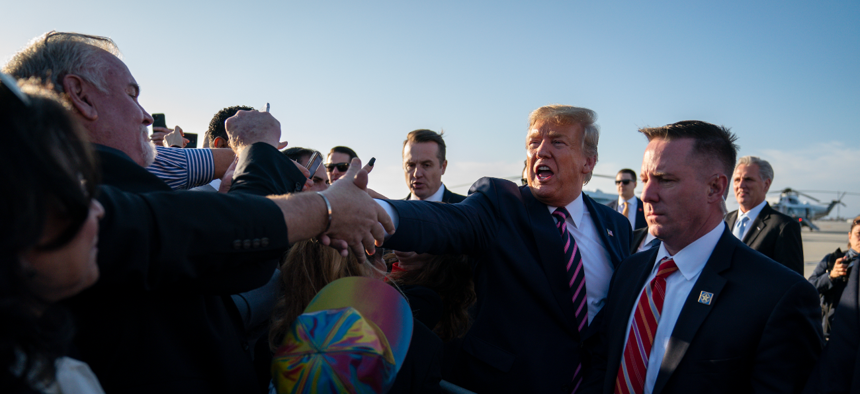
Then-President Trump greets supporters after arriving at Los Angeles International Airport in Los Angeles on February 18, 2020. Public health officials were already warning Americans about the need to prepare for the coronavirus threat. Evan Vucci/AP
At Pandemic's Outset, Trump Admin Risked Exposing Dozens of Feds to COVID-19 to Avoid 'Bad Optics'
Employees put at risk were among the first deployed in the coronavirus response.
The Trump administration failed to protect federal personnel who deployed to California in the opening days of the novel coronavirus pandemic to repatriate Americans returning from Wuhan, China, according to a newly released report.
Dozens of employees at the Health and Human Services Department’s Administration for Children and Families were sent to March Air Force Base in January 2020 to assist with those returning from the initial epicenter of the COVID-19 outbreak. Those staffers were in direct contact with the evacuees without any personal protective equipment, proper leadership or instructions on how to respond, according to multiple internal HHS reports reviewed and made public on Thursday by the Office of Special Counsel. The department did not even send employees from the right organization, according to a whistleblower whose claims launched the investigation and were largely substantiated. The more properly trained employees are located within the Office of the Assistant Secretary for Preparedness and Response.
Special Counsel Henry Kerner released the HHS Office of General Counsel reports and his own findings as part of a letter to President Biden. Kerner blasted HHS for its failure to follow the proper protocols in releasing its reports and for “reprehensible” efforts to discredit a department employee who blew the whistle on wrongdoing, leading him to call the investigations “insufficient and unreasonable.”
HHS eventually released two reports about the incident in California and a similar repatriation effort at Travis Air Force Base, the first in April and a second, much more detailed one, in November after OSC criticized the initial investigation as incomplete. The department sought to defend itself, noting “repatriation and quarantine of this scale has never occurred in the history of the United States.” Still, it highlighted several failures. An incident management team did not arrive on scene until three days after the Americans arrived at March. The ACF employees first deployed did not have access to personal protective equipment or instructions for its usage, the general counsel found, and Centers for Disease Control and Prevention staff set an inconsistent example on when and how to use the equipment. HHS’ direction regarding PPE was “confusing, incomplete, and contradictory.”
On Jan. 30, ACF staff attended a town hall meeting with the evacuees. According to several individuals present, they were instructed to remove their masks and gloves as wearing it was “bad optics.” If images of staff wearing masks became public, the employees were told, it would “illicit negative media inquiries.”
Following direct contact with the evacuees and their belongings, federal personnel flew on commercial planes to return home. Staff also allowed the repatriated Americans to leave the base, even as they were supposed to be quarantining. HHS said none of its employees tested positive for COVID-19, but those individuals did not receive a test at all until mid-March, well after the incubation period for the virus. The whistleblower who brought the claims forward said the federal workers could have spent weeks unknowingly as asymptomatic, or even symptomatic, carriers.
That employee, whose name was redacted, argued the nature of the emergency did not let HHS off the hook.
“A crisis does not excuse the agency’s failure to perform its mission and delegate responsibilities appropriately and safely,” Kerner wrote in his letter, summarizing the whistleblower’s position. She added, according to the special counsel, that the department’s “use of ACF personnel for these missions endangered the health and safety of staff, the evacuees, and the American public.”
Department officials conceded in HHS's second report that government leadership was “reckless with respect to the risk of endangering the broader public.”
The HHS whistleblower took issue with how employees deployed to Travis were treated, suggesting they also had inadequate PPE and training. She added they were supposed to conduct their work virtually, but ended up interacting with repatriated Americans directly. HHS said it had improved its processes when evacuees arrived at Travis, however, and Kerner noted it was “better prepared” for that mission.
The special counsel blasted HHS, however, for its handling of the investigations. Kerner said the department violated federal statute by releasing its reports directly to Congress before first allowing OSC to comment on them. Additionally, individuals deployed to California who were questioned by the general counsel’s office said they “felt threatened” during their interviews. Kerner also faulted HHS for “inexplicably” including in its second report a nine-page addendum seeking to discredit the whistleblower by highlighting minor discrepancies in her retelling of events. Kerner said he was "deeply troubled" by the department's "misconduct," explaining it would have a negative impact on future whistleblowers.
“The inclusion of the addendum appears entirely gratuitous and detracts from the serious deficiencies and dire concerns substantiated in HHS OGC’s report,” Kerner wrote.
Bill Hall, an HHS spokesman, declined comment on the activities of the previous administration. Kerner’s Thursday letter followed one on Wednesday in which his agency substantiated allegations that HHS spent many years misusing millions of dollars that Congress had allocated to vaccine research and development.







